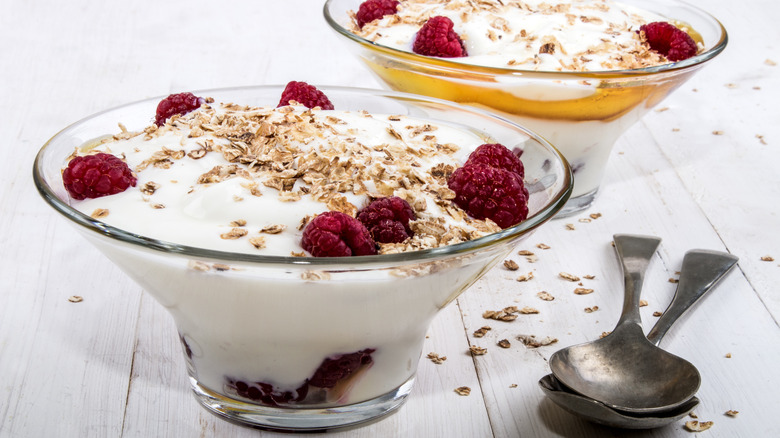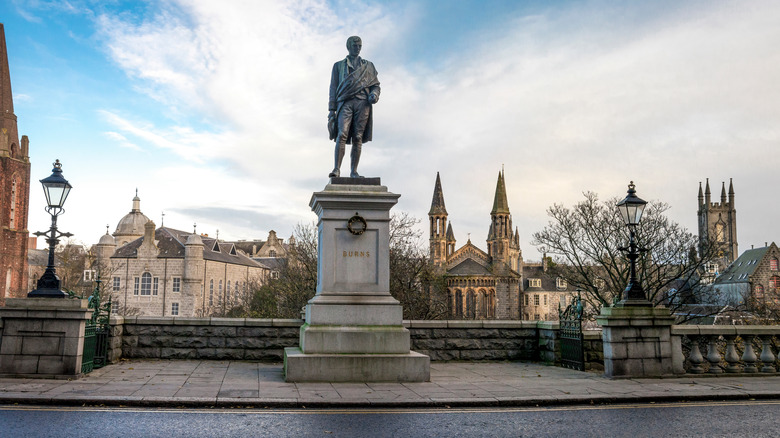Cranachan: The Boozy Scottish Whipped Cream Dessert You Need To Try
Perceptions of Scotland's cuisine seem to always hinge on the notorious reputation of haggis (despite the fact that haggis doesn't even have Scottish origins). While the dish has become as much an emblem of the country as kilts and bagpipes, it also overshadows numerous noteworthy foods that ought not to be ignored. To better appreciate Scottish cuisine, let us turn our attention to cranachan, a name that simply begs to be uttered in a thick Scots brogue. The Guardian called it "The uncontested king of Scottish desserts," but it's sure to be a crowd-pleaser anywhere.
Cranachan typically consists of raspberries, toasted oats paired with whiskey-infused whipped cream, and a drizzle of honey. It bears some resemblance to Eaton mess, a popular dessert in England, though the use of oats, Scotch whiskey, and raspberries makes it distinctly Scottish. Cranachan was initially prepared for harvest celebrations when raspberries were just coming into season. However, with stores now carrying berries throughout the year, it has become a staple of menus every season. Sweet, tart, and boozy, it has everything you could ask for in a dessert and more — which is why it's so weird that cranachan wasn't originally a dessert at all.
Cranachan was originally eaten for breakfast
Believe it or not, cranachan was initially served as the first meal of the day. It's not that odd when you think about it, as cranachan is basically a parfait with whipped cream instead of yogurt. And if the thought of whiskey for breakfast makes you raise an eyebrow, relax. Cranachan uses a minimal amount of Scotch — about a tablespoon per serving — just enough to lend a slightly smoky flavor to the mix.
Cranachan can be assembled in different ways, leading to multiple dish variations. Some choose to layer the ingredients in a glass dish, as you would with a trifle, while others simply stir everything together, the cream turning pink from the raspberry juice. Fancier versions might make use of a raspberry purée or coulis.
The name cranachan comes from Scottish Gaelic, meaning "churn." You'd think this was due to the whipped cream element, but the original version of the dish didn't actually use this ingredient. Old recipes for cranachan call for crowdie, a soft and tangy cheese made from raw cow's milk. However, laws banning the sale of unpasteurized milk made crowdie extremely rare, opening the doors for whipped cream to take its place in cranachan.
It is a staple of Burns Suppers
The best way to enjoy cranachan is as part of a traditional Burns Supper. A Burns Supper (also known as a Burns Dinner or Burns Night) is a celebration of Scotland's national Poet, Robert Burns, held every year on January 25th to mark the anniversary of his birth in 1759. Burns is a cultural icon in Scotland, hailed by some as the nation's favorite son, and the Scots go all-out for these honorary birthday parties. They feature speeches, recitals of Burns's poems, and a glorious amount of food and drink.
A Burns Supper features multiple courses, beginning with one of many traditional Scottish soups. The event's centerpiece is a main course of haggis, brought to the table in grandiose fashion accompanied by a bagpiper. For dessert, it's cranachan, which is a delightfully bright refresher after the previous hot and heavy courses. At the end of the night, stomachs full of berries, cream, and whiskey, the guests rise and sing Burns's most famous work: "Auld Lang Syne," before heading home for what will surely be a deep sleep.


